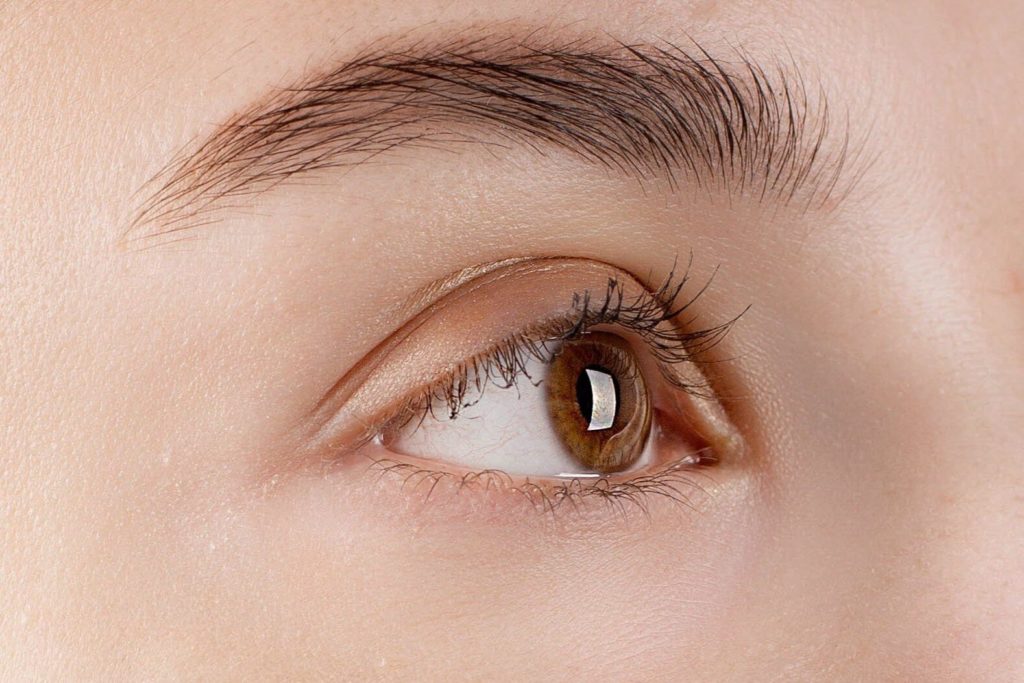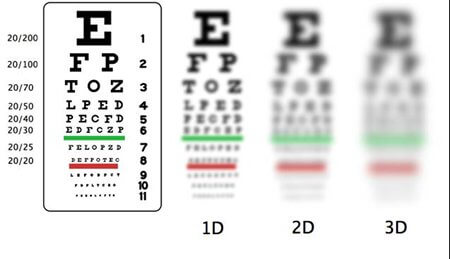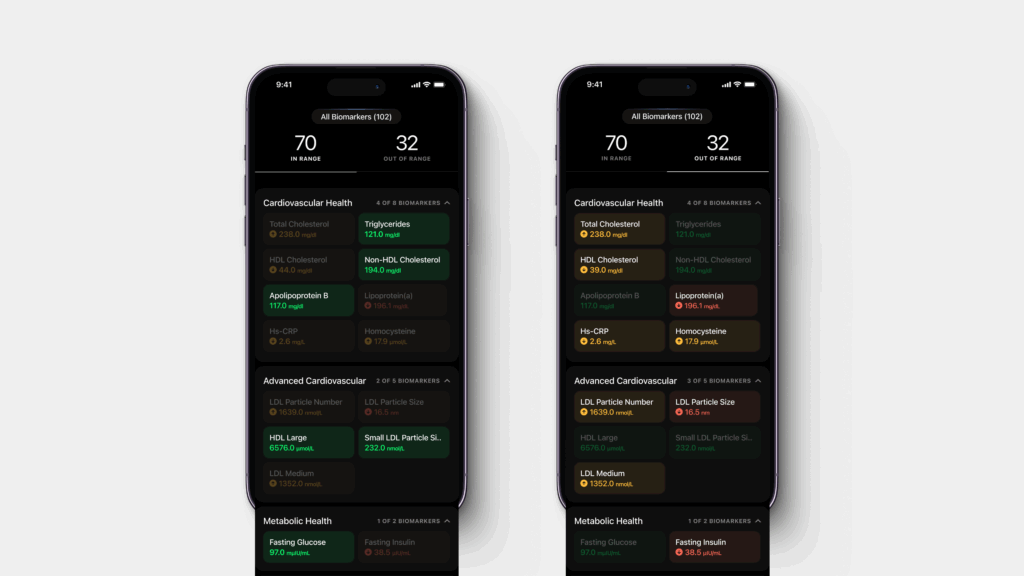Did you know that eating too many cupcakes could not only spike your blood sugar but also seriously impact your eyesight? Studies suggest that those who experience chronically elevated blood sugar levels are more likely to suffer from eye disease and conditions such as glaucoma, cataracts, blurry vision and retinopathy. It’s the leading cause of blindness in adults aged 20–74. Let’s look at how blood glucose levels affect our vision and what we can do about it.

Highlights
- Blurry vision, particularly after eating a high carbohydrate meal, can indicate high blood sugar levels,
- High blood sugar levels may also cause temporary thickening or swelling of the eye lens, resulting in vision fluctuations. This includes temporary near-sightedness (myopia),
- One of the ways to prevent eye disease and damage from high blood sugar is to eat foods that don’t spike your blood glucose levels.
How high blood sugar affects eye health
1. Inflammation and eye disease
Sugar is a pro-inflammatory agent. When we eat too much sugar or carbohydrates, our body releases an excess of insulin to regulate the glucose levels in our bloodstream. This surge of insulin and sugar causes inflammation in our cells, which damages our blood vessels. The tiny blood vessels in our eyes are particularly fragile and sometimes the downside of eating too much sugar is noticeable in the eyes soon after eating.
Metabolic syndrome causes inflammation and damage of blood vessels, including the microvessels in the retina. One study showed that blood flow in the eye was altered in people with impaired glucose tolerance before they developed cardiovascular disease or diabetes.
2. Blurry vision
Blurry vision, particularly after eating a high carbohydrate meal, can indicate high blood sugar levels (postprandial/post-meal hyperglycemia). It occurs because of the following: –
- A sudden increase in glucose levels makes the lens of the eye swell. This is caused by fluid moving in and out of the eye through damaged blood vessels.
- The swelling, in turn, changes the shape of the lens and affects vision.
- When blood sugar levels return to normal, the swelling subsides and regular vision is restored, usually within a couple of days (but can take up to three months).
Consistent high blood sugar levels can ultimately lead to diabetes and even complete vision loss.
To prevent blurry vision after eating, try to decrease the carbohydrates you eat and choose foods that gradually increase your blood glucose instead of foods that cause sharp glucose spikes. These foods will have a low glycemic index (GI) rating, which is a score between 0 and 100. The higher the score, the more the food will raise your blood sugar levels. Examples of low GI foods (with a rating of less than 55) include rolled oats, barley, non-starchy vegetables and most fruits.
Exercise is also a fantastic way to lower your blood sugar levels and keep them in a safe range. Research shows that a mere 15-minute walk after a meal can help manage blood sugar levels for up to 24 hours.
3. Glaucoma
Glaucoma is a disease of the eye caused by severe inflammation and pressure build-up. When fluid can’t drain the way it should, it can damage the nerves and blood vessels of the eye, resulting in disturbances in vision.
In certain types of glaucoma, you may also experience eye pain, watery eyes, blurred vision, headaches, halos around lights and vision loss. If you have very high blood sugar you are also at a higher risk of getting a rare condition called neovascular glaucoma. This disease causes new blood vessels to grow on the iris (coloured part of the eye) and blocks the normal flow of fluid.
Patients with a high body mass index (BMI) or those who have other symptoms of metabolic syndrome are at a higher risk of developing open-angle glaucoma.
There is a further unique form of glaucoma (known as neovascular glaucoma) that can develop in people who have high blood sugar or diabetes. New blood vessels grow in the eye’s drainage system and can increase the pressure in the eye as the fluid builds up. The longer someone has chronically elevated blood sugar levels, the higher their risk of developing this type of glaucoma
4. Cataract risk
A cataract is a condition that causes clouding of the lens inside the eye. The lens bends light that enters the eye to focus it on the retina, much like a camera lens does when you focus on an object.
When you have a cataract, the lens is milky and opaque, and it can no longer bend light effectively. This results in blurry and cloudy vision.
Metabolic syndrome is associated with cataracts.
Research shows that the risk of cataracts increases with each aspect of metabolic syndrome, especially high blood sugar levels and elevated blood pressure. In fact, when combined with obesity and low high-density lipid levels, the risk increases seven-fold. Just high blood sugar and pressure alone will make you four times more likely to develop cataracts.
Recovery after cataract-removal surgery is also more complicated for patients with fluctuations in their blood glucose levels and can result in permanent damage to the retina.
5. Diabetic retinopathy risk
The retina refers to a group of cells behind your eye responsible for taking in light. If the small blood vessels in the retina are damaged (such as through high blood sugar levels), it can cause diabetic retinopathy and could lead to a loss of vision. Diabetic eye is a term for a group of eye conditions that often affect people with diabetes. The most common of these is diabetic retinopathy. Others include macular oedema, cataracts, and glaucoma. Dr Mallikarjuna, Assistant Professor in the Department of Endocrinology at Sadhana Clinic, Davanagere, tells a leading publication that unregulated blood sugar levels can damage blood vessels supplying to the light-sensitive tissue present in the retina. ‘With time, uncontrolled blood sugar levels can cause irreversible damage to your eyes,’ she adds.
Early signs of the diabetic eye include:
- Difficulty in perceiving colours
- Blurry vision
- Difficulty seeing at night
- Dark strings or spots floating in the field of vision
6. Dry eye disease
Our eyes naturally produce fluid (tears), which protect them from pollutants and other damage. Dry eye is a disease of the eye surface that occurs from low quality or volume of tears. This results in dryness, irritation and ultimately damage to the surface of the eye (cornea).
There are a number of things that can lead to dry eyes, such as poor nutrition, bad eye hygiene and insufficient blinking. Unfortunately, it doesn’t only cause mild discomfort. It can dramatically affect vision and put one at an increased risk of infection, scarring, painful ulcers, corneal damage and blindness.
People with high blood glucose levels are at a higher risk of dry eye, which hampers tear production.
7. Temporary vision changes
High blood sugar levels may also cause temporary thickening or swelling of the eye lens, resulting in vision fluctuations. This includes temporary near-sightedness (myopia).
One study found that by mimicking the state of hyperglycemia, an induced 400% increase in blood glucose levels resulted in a near-sighted (myopic) shift of two dioptres. A diopter is a unit used to measure near or farsightedness. This sudden change in vision reverted to normal when blood glucose levels stabilized.
To get an idea of how great a shift this is, below is an image that depicts a one, two and three-dioptre difference (compared to 20/20 vision on the left).

8. Stroke in the eye
Elevated blood sugar levels and high blood pressure damage blood vessels, including those in the eye. This damage may result in a vein or artery blockage also referred to as an occlusion. Retinal vascular occlusions (or strokes in the eye) can cause sudden vision loss, and may even indicate that a systemic stroke in the brain is imminent.
One study showed that 53% of participants with a history of retinal vein occlusions had reduced arterial blood flow to the retina and showed abnormal results on a glucose tolerance test. In other words, poor glucose metabolism can put you at a higher risk for a stroke in the eye.
How to prevent eye complications due to high blood sugar
Monitoring blood glucose levels regularly is the most important preventive measure.
Fibre consumption can aid blood sugar management. Fruits and green leafy vegetables are low on the glycemic index. Studies indicate that eating a low-carbohydrate, high-protein diet reduces blood sugar levels over the long term and prevents sudden glucose spikes. Post-meal walks have been backed by research and show the stabilizing of blood sugar levels after meals.
Other good habits include reading food labels and looking out for hidden sugars, staying active and going for regular eye exams.
Conclusion
The tiny blood vessels in our eyes are particularly fragile. Sometimes the detrimental effect of eating too much sugar can manifest instantaneously. A sudden increase in glucose levels can cause the lens of the eye to swell. This is caused by fluid moving in and out of the eye through damaged blood vessels. The swelling, in turn, changes the shape of the lens and affects vision. High levels of blood sugar can negatively impact eye health and vision, resulting in conditions such as inflammation, blurry eyes, glaucoma, cataract, ‘diabetic eye’, dry eye disease, vision changes and stroke in the eye. Fortunately, it can be moderated by monitoring blood sugar levels regularly and implementing lifestyle changes like post-meal walks, high fibre intake and consumption of low GI foods among others.
Disclaimer: The contents of this article are for general information and educational purposes only. It neither provides any medical advice nor intends to substitute professional medical opinion on the treatment, diagnosis, prevention or alleviation of any disease, disorder or disability. Always consult with your doctor or qualified healthcare professional about your health condition and/or concerns and before undertaking a new health care regimen including making any dietary or lifestyle changes.
References
- https://www.webmd.com/diabetes/diabetes-eye-problems/
- https://www.verywellhealth.com/blurry-vision-after-eating-5118069
- https://iovs.arvojournals.org/article.aspx?articleid=2127087
- https://pubmed.ncbi.nlm.nih.gov/16401783/
- https://indianexpress.com/article/lifestyle/health/diabetic-eye-increased-blood-sugar-levels-symptoms-treatment-7487107/








